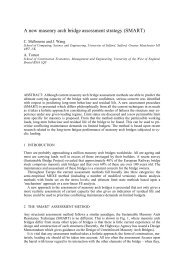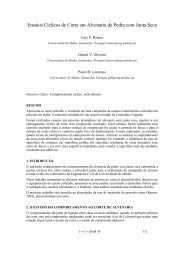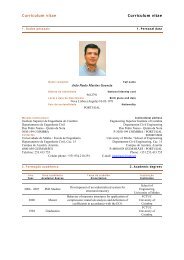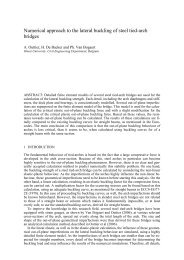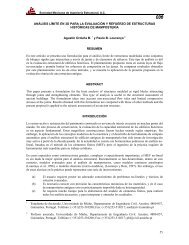an orthotropic continuum model for the analysis of masonry structures
an orthotropic continuum model for the analysis of masonry structures
an orthotropic continuum model for the analysis of masonry structures
Create successful ePaper yourself
Turn your PDF publications into a flip-book with our unique Google optimized e-Paper software.
24 1995 TNO-95-NM-R0712since <strong>the</strong> original work <strong>of</strong> Baº<strong>an</strong>t <strong>an</strong>d Oh (1983). As stated in Section 2., in <strong>the</strong> present work h isassumed to be related to <strong>the</strong> area <strong>of</strong> <strong>an</strong> element, cf. eq. (13). However, this approach is generallyused in engineering practice only <strong>for</strong> <strong>model</strong>ling tensile behaviour with linear elastic pre-peakbehaviour followed by inelastic s<strong>of</strong>tening until total degradation <strong>of</strong> strength.The constitutive relation shown in Fig. 16 features pre-peak hardening <strong>an</strong>d a residual plateau.Clearly, <strong>the</strong> hardening br<strong>an</strong>ch <strong>of</strong> <strong>the</strong> constitutive relation is stable <strong>an</strong>d should not be adjusted as afunction h but also <strong>the</strong> residual plateau is const<strong>an</strong>t <strong>an</strong>d independent <strong>of</strong> <strong>the</strong> h value. To demonstrate<strong>the</strong> veracity <strong>of</strong> <strong>the</strong> deÞnition <strong>of</strong> a mesh independent release <strong>of</strong> energy upon mesh reÞnement <strong>an</strong>example <strong>of</strong> a simple bar loaded in uniaxial is given. The problem is similar to <strong>the</strong> well-known problem<strong>of</strong> a simple bar loaded in tension proposed by CrisÞeld (1982).Consider <strong>the</strong> bar shown in Fig. 20 which is divided in n elements with n = 10, 20 <strong>an</strong>d 40 elements.The length <strong>of</strong> <strong>the</strong> bar is 50 mm <strong>an</strong>d <strong>the</strong> tr<strong>an</strong>versal section <strong>of</strong> <strong>the</strong> bar has unit dimensions(1. 0 mm 2 × 1. 0 mm 2 ). The compressive fracture energies are assumed to equal G fcx = 10. 0 N/mm<strong>an</strong>d G fcy = 5. 0 N/mm. For <strong>the</strong> rest <strong>of</strong> <strong>the</strong> material properties <strong>the</strong> values used in <strong>the</strong> previous sectionare assumed. One element is slightly imperfect (10%) to trigger <strong>the</strong> localization: f cx = 9. 0 N/mm 2 ,f cy = 4. 5 N/mm 2 ,G fcx = 9. 0 N/mm <strong>an</strong>d G fcy = 4. 5 N/mm. The o<strong>the</strong>r material parameters remain<strong>the</strong> same.Imperfect elementFig. 20 - Simple bar with imperfect element loaded in compressionThe load-displacement response <strong>of</strong> <strong>the</strong> bar is depicted in Fig. 21a <strong>for</strong> <strong>the</strong> energy-based regularizationmethod (note that ÒdisplacementÓ is understood as <strong>the</strong> relative displacement between <strong>the</strong> ends<strong>of</strong> <strong>the</strong> bar). It c<strong>an</strong> be observed that <strong>the</strong> response is totally independent from <strong>the</strong> number <strong>of</strong> elements.The response <strong>of</strong> <strong>the</strong> bar with a constitutive <strong>model</strong> which has not been modiÞed by <strong>the</strong> size <strong>of</strong> <strong>the</strong>Þnite element mesh, see Fig. 21b, shows a dramatic mesh-dependent behaviour in <strong>the</strong> post-peakresponse. The brittleness <strong>of</strong> <strong>the</strong> response increases with <strong>an</strong> increasing number <strong>of</strong> elements.10.010.0Load [MN]8.06.04.0n = 10, 20 <strong>an</strong>d 40Load [MN]8.06.04.0n = 20n = 102.02.0n = 400.00.0 10.0 20.0 30.0 40.0 50.0-3Displacement [10 mm]0.00.0 10.0 20.0 30.0 40.0 50.0-3Displacement [10 mm]a) Energy-based regularization b) No regularizationFig. 21 - Load-displacement diagram <strong>for</strong> simple bar with imperfect element


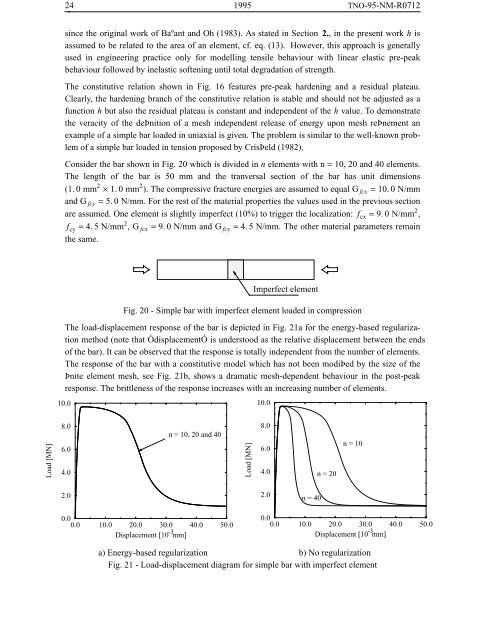
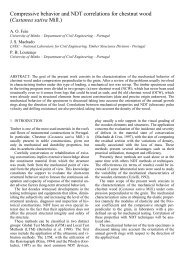
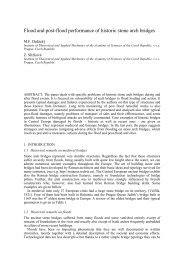
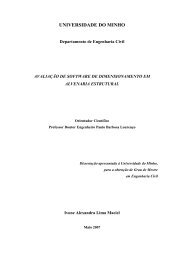

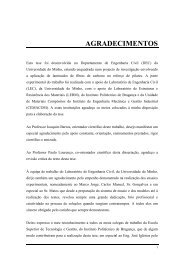

![Weibull [Compatibility Mode]](https://img.yumpu.com/48296360/1/190x134/weibull-compatibility-mode.jpg?quality=85)

